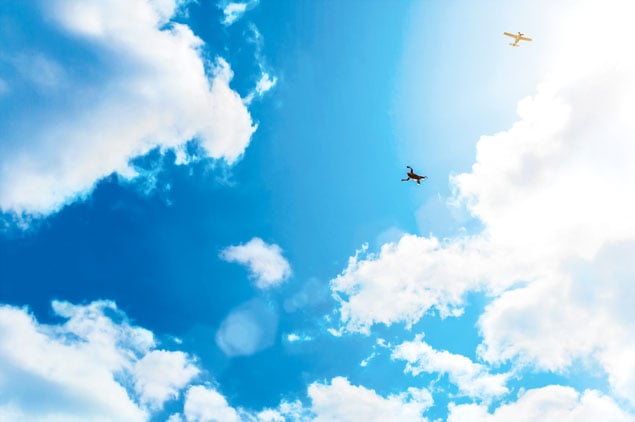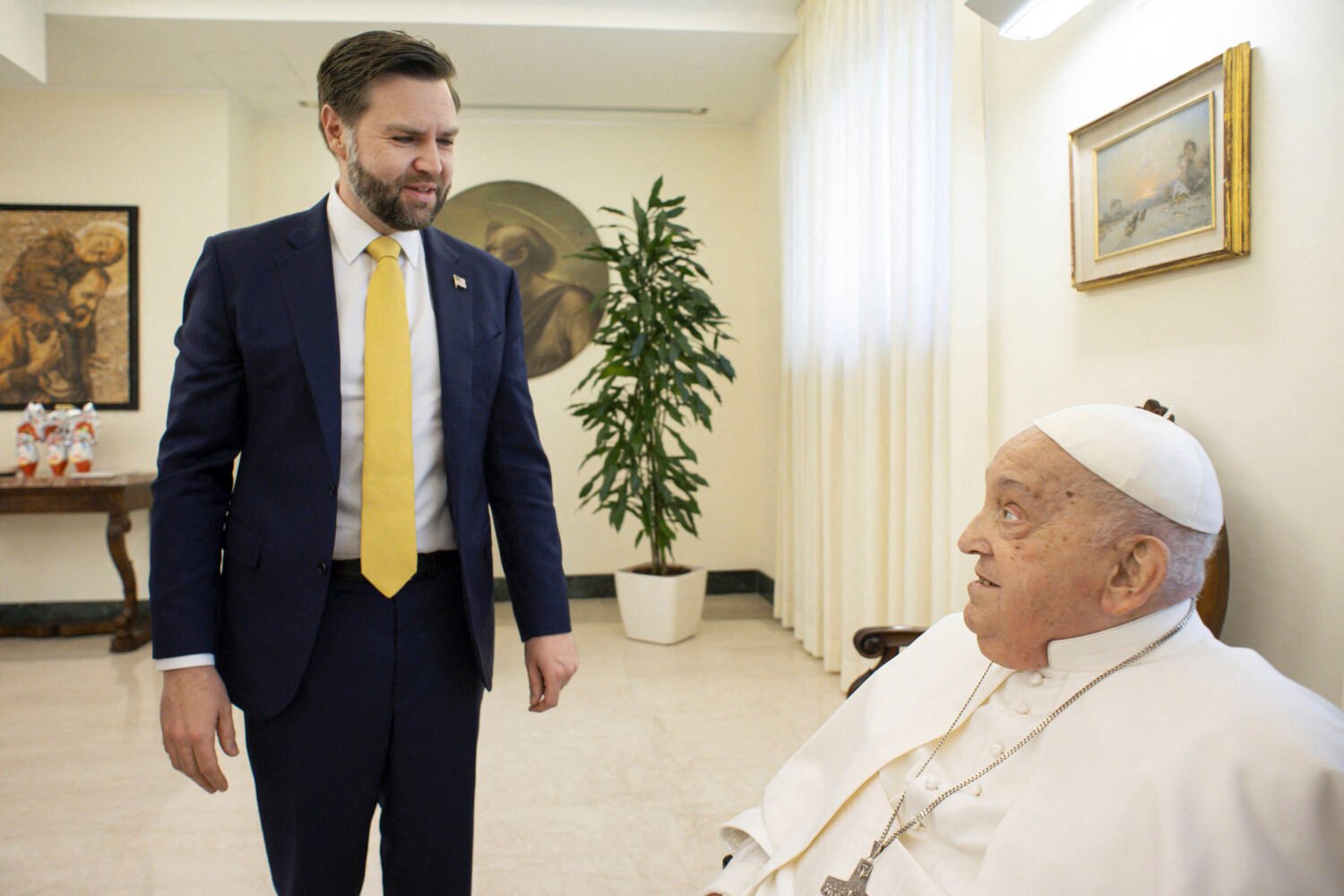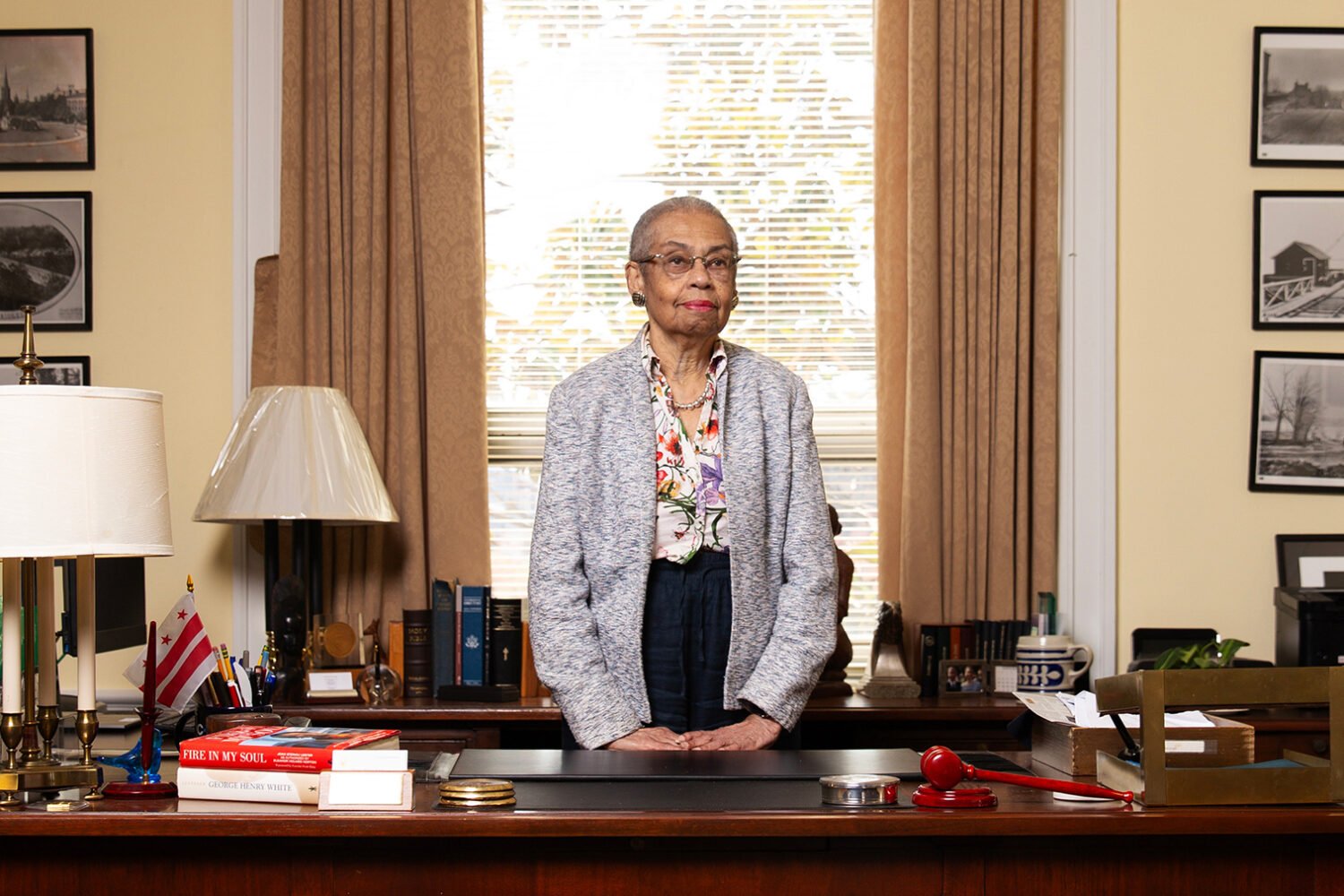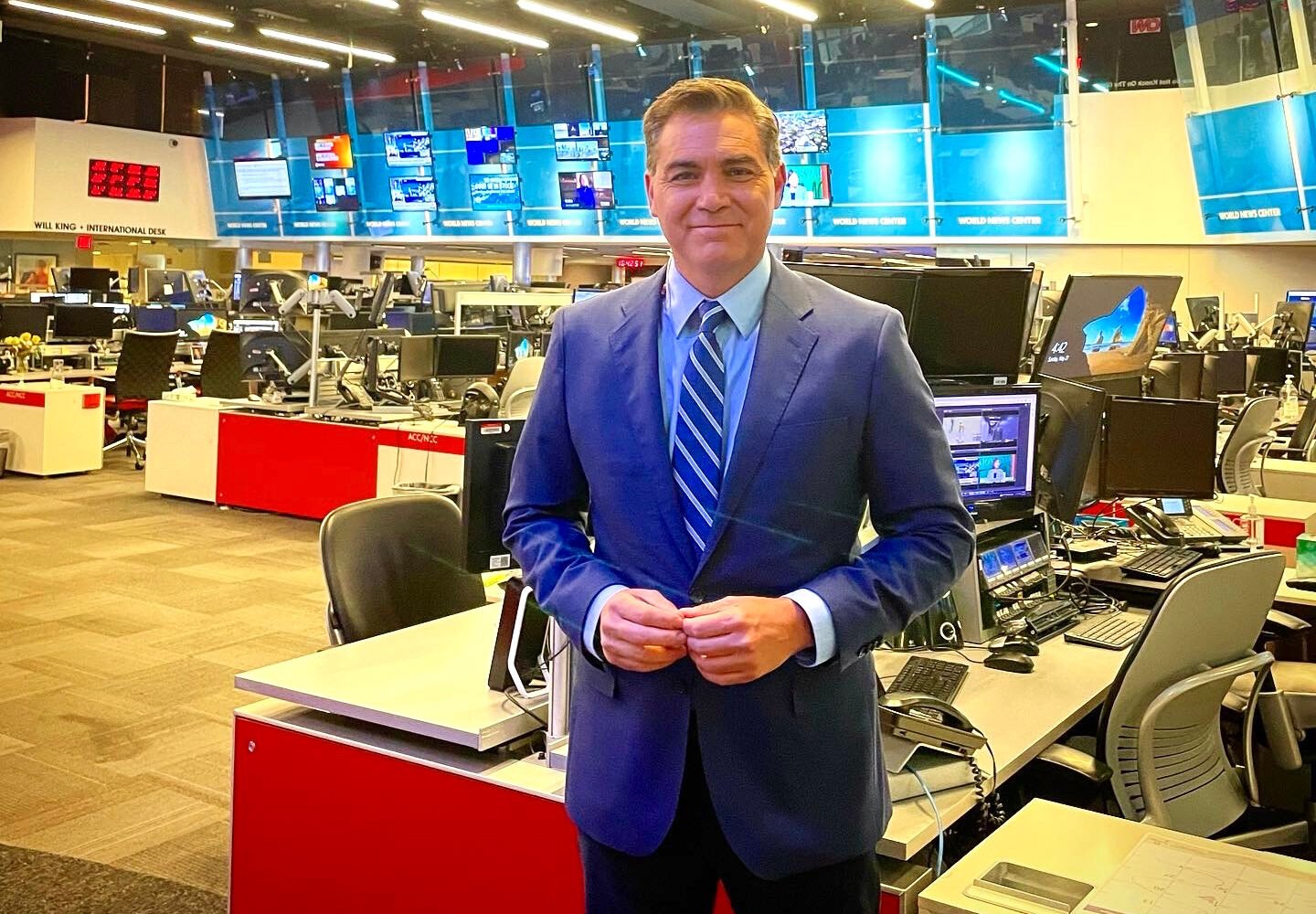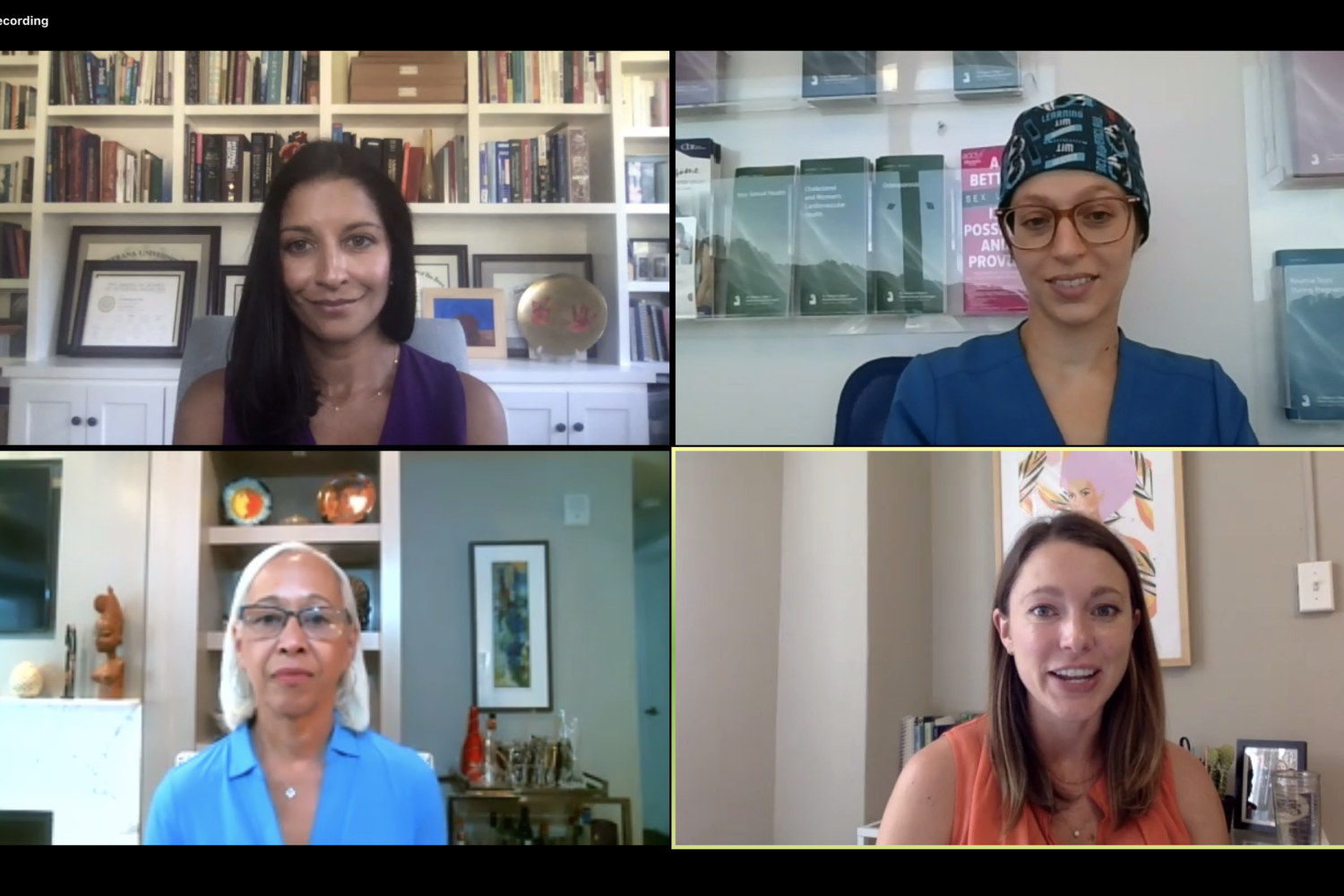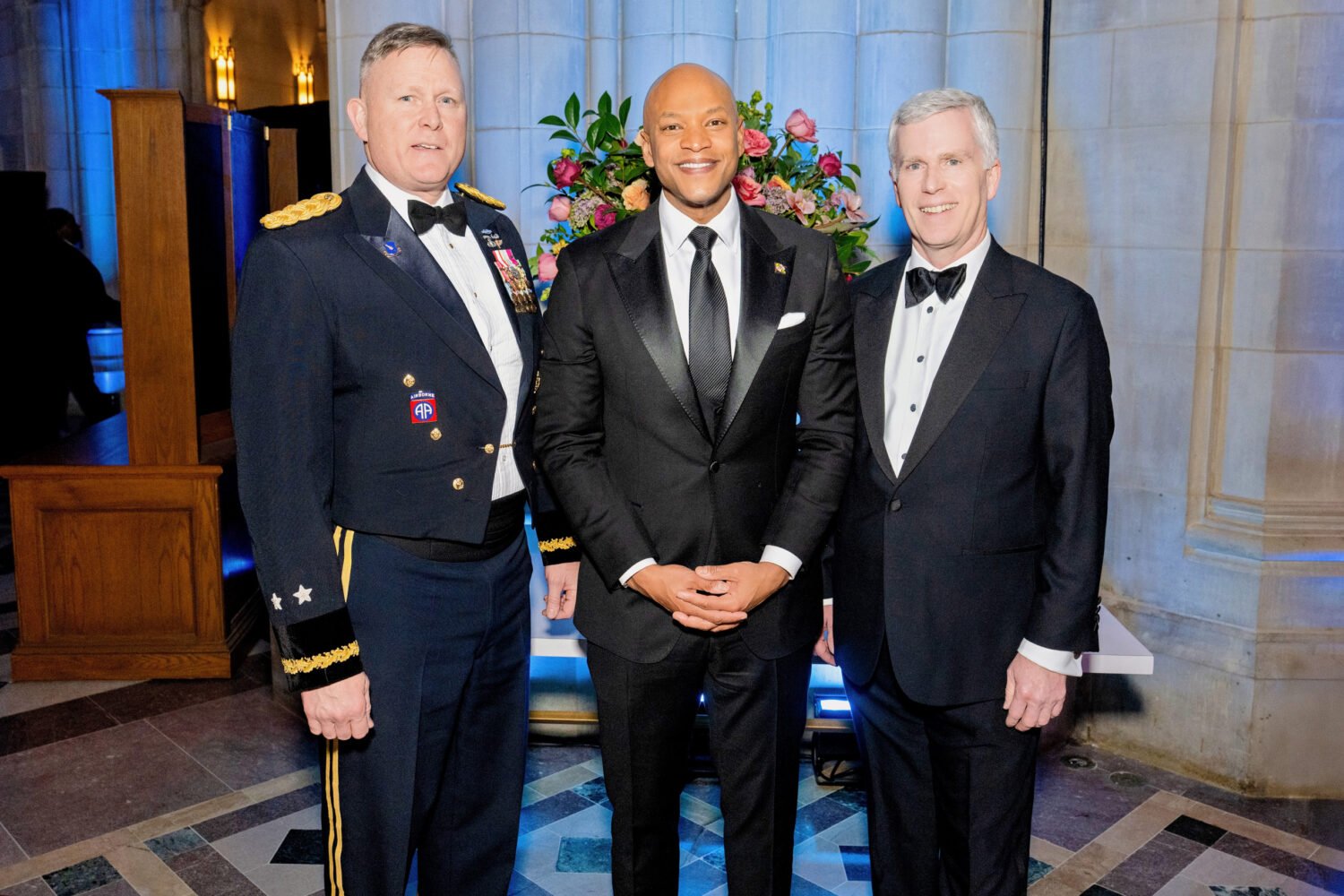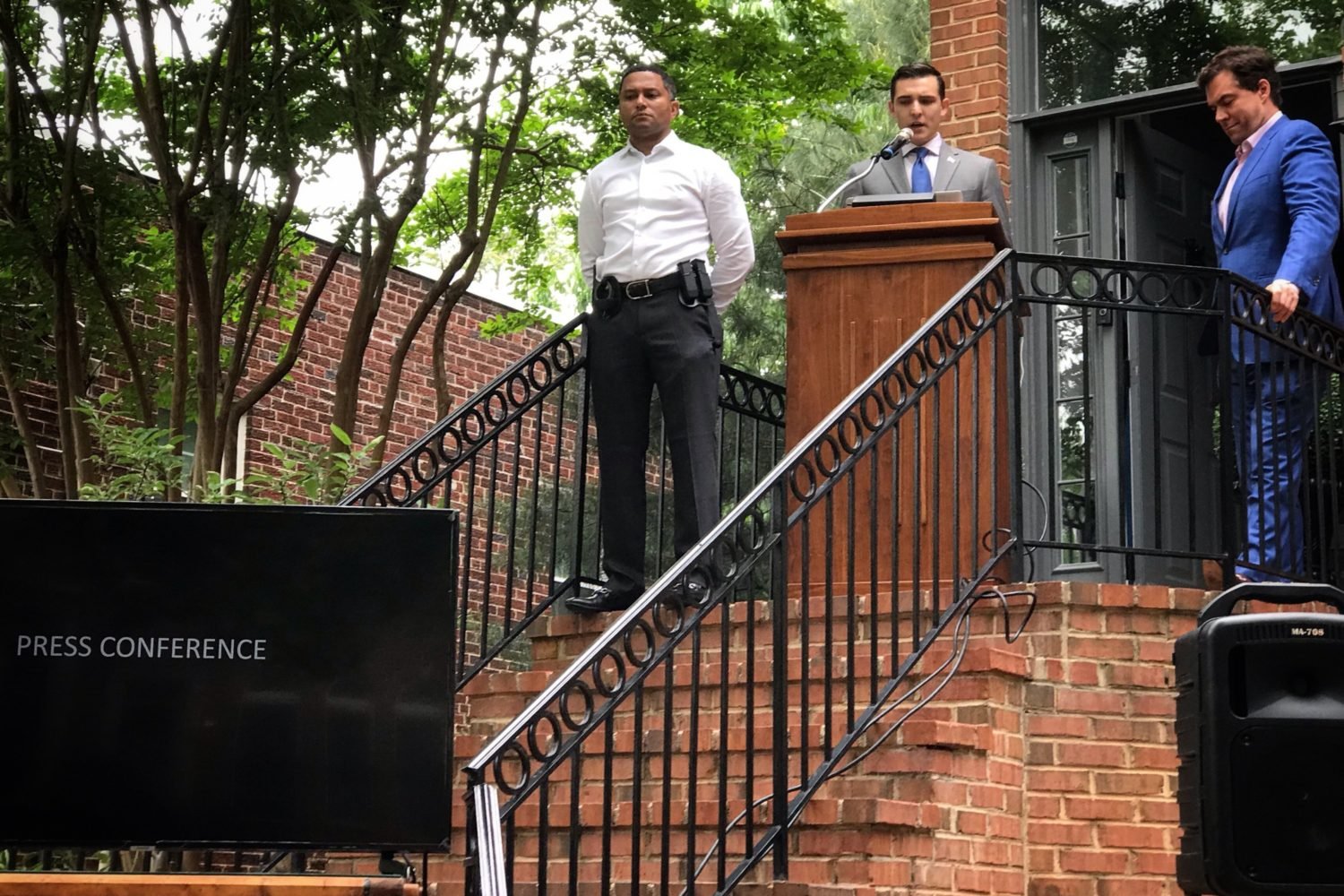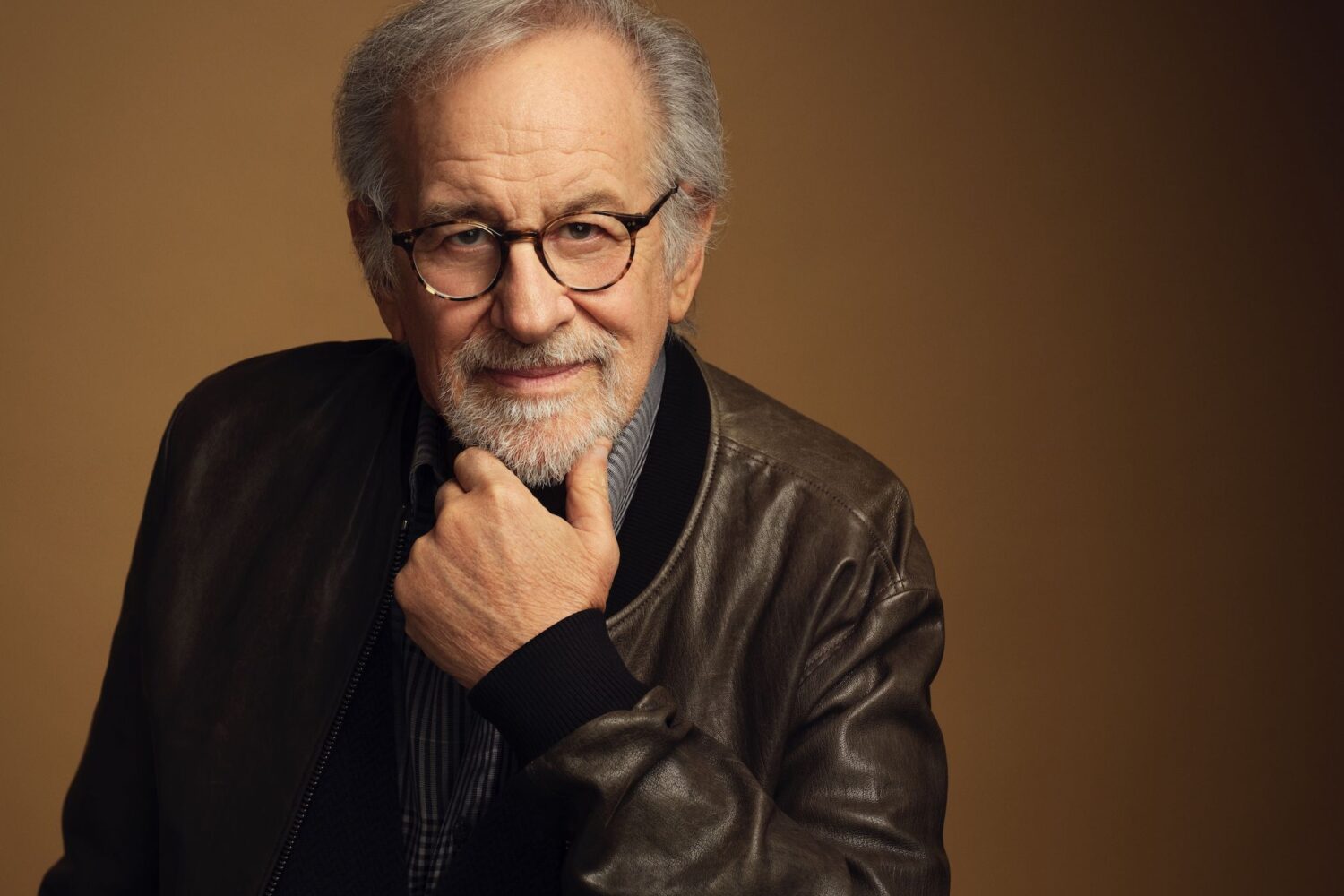He’s sitting on his couch, shirtless, hunched over a hard-earned belly, breathing hard-earned air, in and out, trying to remember. His face droops, and his right side is numb.
“Aw, Christ,” he says. “What the hell am I trying to say?”
We’re attempting to steer around the blotches of white matter on his brain.
“You were talking about the raccoon,” I remind him.
The raccoon. Yes. He remembers this. Back there, somewhere, along about 1967.
He was 23 years old, and on a fine afternoon on the Eastern Shore of Maryland, he was about to throw a dead raccoon from an airplane when something bad happened. The wind caught the pilot chute that was tied to the animal and sucked it into the sky. The chute broke off and fell slowly to the earth. The dead raccoon fell faster.
Fearless Freddie Giraffe, as they called him then, was a skydiver, and a good one. He would soon become the 647th American to earn his gold wings, an award bestowed only on crazy-asses like him who jump out of a plane more than 1,000 times. He was a member of an elite club of sport parachutists, the Pelicans. He could jump from 12,000 feet in the air and land on a ten-centimeter-round target on the ground, dead center. He could do that in the morning, or at night, or hung-over out of his mind. Yet at this moment, Fearless Freddie was scared to death.
“Where’d you get the raccoon?” I interrupt, trying to piece together his scattered memories one afternoon last summer.
“Well, Lowell Dix was sitting in the airplane facing backward. So I took the pilot chute and put it on a 550 cord. I picked the raccoon up off the side of the road. I reckon it wasn’t dead long.”
This silly prank, meant to stir a few laughs from his skydiving buddies—a dead raccoon in a parachute is funny, right?—tumbled in a bad way. In the field below was a small plane, a beautiful plane, a Beechcraft Bonanza. It had been flown to the field by Bill Ottley, one of the most famous skydivers in the world, a future director of the US Parachute Association, and a Pelican. Ottley parked the shiny plane as far from the crowd as possible, not wanting it to get dinged.
“William H. Ottley,” he clarifies. “He’s been dead about three years now.”
Fearless Freddie wished for a gust of wind to push the raccoon one way or the other. But gravity, he’d come to learn during the course of his life, is stronger than a man’s wishes. And on that fine day in 1967, a small legend was born when a flying raccoon smashed into the wing of an airplane.
“Then what?” I ask.
“When I threw the raccoon out of the plane, I jumped from 1,200 feet, because I was over a school.”
“Okay, slow down,” I tell him as we work toward the ending together.
Fearless Freddie watched from above as the raccoon hit the Beechcraft Bonanza, and horror set in. He worried he’d be sued or, worse, that Ottley would expel him from the Pelicans, a group he considered family.
He told the pilot to keep flying, to find a safe place to jump, far from the drop zone. The plane hummed above the Eastern Shore’s flat farmland for about a dozen miles before reaching a school and a football field. He could hitchhike from there, he thought. And so, long before he became a husband, long before he became a father to two sons, long before the first stroke, the second stroke, the third stroke, and the three more after that, Fearless Freddie strapped on his parachute, thanked the pilot for the lift, and then the man who’d become my father hurled himself toward the hard earth once more.
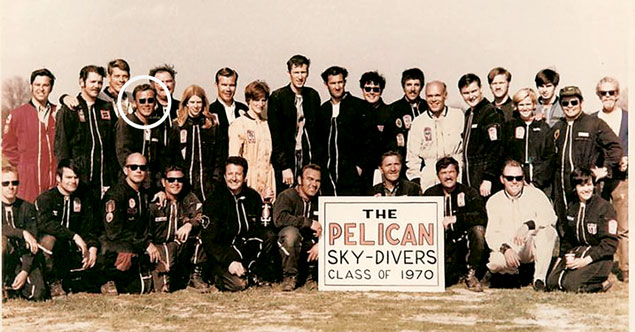
Hi, Mike. This is your old man. I’m just calling to say you missed this call, okay?
I started saving phone messages from my father about three years ago. I live in North Carolina, and he and my mother still live in the home where I grew up in southern Maryland. Sometimes I intentionally miss the call, just to capture his voice.
One of the longest messages is 27 words, and it came in when I was at the North Carolina coast a few years ago researching a story about an old storm. Hi, Mike. Yeah, you need somebody to give you the story on Hurricane Hazel? I’m available. 1954—you’re right. Okay, I was ten years old then. Bye-bye.
The shortest is seven words.
Hey, Mike, it’s just me. No problem.
• • •
In March 2011, he lay in a bed at Washington Hospital Center, staring at his two sons and wife, trying to speak to us. But he couldn’t. His green eyes darted sideways and up and down.
At no point has his life been easy. He’s been a heavy drinker, and quit that. He’s been electrocuted, and walked that off. He once took a line drive to the head at one of my baseball practices, and when the ambulance arrived, he told the driver to go back to where he came from. He spent much of his youth getting whipped by nuns and his father, yet when he became a father himself, he never struck me or my brother, Kenny. Not once. We grew up afraid not of a belt or an open hand but of disappointing him.
He was, at various points in his life, a welder, a carpenter, an electrician, and a charter-boat fishing captain. As much as those jobs abused his body, when he saw his sons graduate from college, he told us that every ache was worth it. But that night in the hospital, he was in pain of a different kind: He was confused, and when you’ve lived 66 years, being confused is the worst kind of affliction. So he cried.
He’d been admitted a few nights earlier after suffering his third stroke. Doctors discovered coronary disease and a severe blockage of his left carotid artery. They immediately scheduled surgery to place a stent in the artery to clear the blockage. Everything went to hell. During surgery, he suffered three more mini-strokes, or transient ischemic attacks, or watershed infarcts, as they’re labeled in his medical reports. In other words, his brain fell under attack by a river of his own blood, carrying pieces of his own blockage.
That night, after he cried, he closed his eyes and started to shake. Seizure. The event lasted about an hour. One of the doctors looked at me and my brother, mouth wide open, and then looked down at the cold floor. Another doctor wiped away a tear as she hugged my mother.
Another pulled us into the hallway and explained that they weren’t sure what his brain was doing. But we should go home, he said. And we should be prepared for Dad to die. He’d call us if something happened. I remember my mother—a first-grade teacher and his wife of more than 30 years—crumpled to her knees in the elevator on the parking deck that night. I carried her to the car. I was 31 years old, and I was preparing for life without a father.
We woke up the next day and returned to the hospital. We parked, checked in, went down a few long corridors and up an elevator and down another corridor to his room, and then we opened the curtain to his bed.
He was there, very much alive, but in a different way—smacking his lips together, pressing a plastic spoon down in a plastic cup, mashing it like a child, lips squeezing down on his tongue. My father, a man who had more than 1,000 parachute jumps, trying to figure out how to go about the rest of his life, starting with a simple spoonful of applesauce.
• • •
The left hemisphere is the brain’s library. It catalogs experiences. The right hemisphere is the fun side, the one that enjoys the moment. The left is the practical side, the side that remembers why we need to go home at curfew.
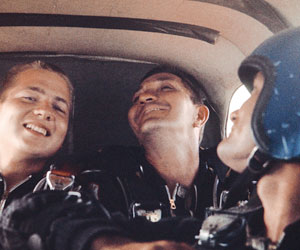
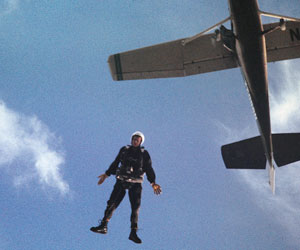
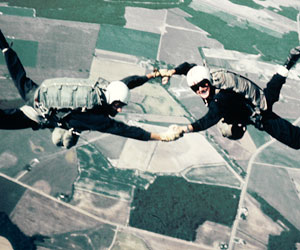
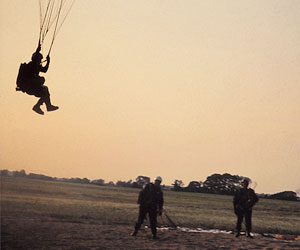
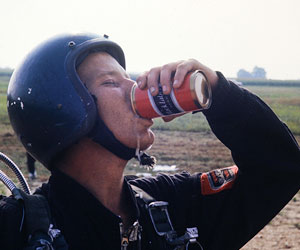
I recently purchased all of my dad’s medical records since 2008. The records from his three-week hospital stay in March 2011 fill 103 pages. They include words I don’t understand, and “stroke” is written very few times. Rather, strokes are disguised as “cerebrovascular accidents.”
In the few images I’ve seen of my father’s brain since then, the left side is dotted like the moon with dead areas, places where memories have been lost forever. Some of the loss is good. For most of his adult life, he was depressed and anxious, to the extent that I knew his therapist’s name—Janet. Now he doesn’t worry about much, and Janet is a piece of his past.
He can’t eat or take showers without help. He falls a lot. Mentally, he’s stubborn. But he’s always been stubborn. Now it’s endearing. If he asks for a cup of coffee, he wants it now, and it’s all he’s thinking about. He’s also very lighthearted, as if these “accidents” have freed him from the concerns of life, of the past, of the future. There is only now. He laughs constantly. And he’s enchanted by danger again.
We were in a restaurant last summer on the day that daredevil Nik Wallenda was scheduled to walk a wire across the Grand Canyon. The televised broadcast was to start around 8, and my father was intent on watching it. At 7:15 or so, we finished eating and the waiter asked if we wanted anything else, “Nope, just the bill,” my father blurted. “We gotta go watch a guy die.”
He lives a life without context, and in some ways I envy that comfortable space.
More interesting, though, is to see which memories remained after the strokes and which were lost. Last summer, I took him to the NASCAR Hall of Fame in Charlotte. That morning, I had to help him remember how to button his pants. But when I pushed his wheelchair through an exhibit of old racecars, he asked me to stop at each car, where he named every vehicle’s year and make: “That’s a ’59 Oldsmobile,” he’d say in clear, crisp words. I’d wheel him forward and read the exhibit descriptions. He had each one exactly right.
When you’re a son and your dad loses most of his memories, you selfishly hope that the ones he keeps are memories of you. Not long after my dad returned home from the hospital in 2011, he started to talk more about things from his past, and it became clear that throughout my childhood, he had shielded us from the life he’d had before starting a family.
He remembered his teenage years and his twenties, the years before we were born, and when he talked, he didn’t just reminisce about the people who filled his life then, many of whom I’d never heard of; he described them in remarkable detail, down to some of their middle names. He has, in scattered frames, revealed a frustrating and troubled childhood, and the freedom he found when he joined the Pelicans and started falling through the air with them.
• • •
Jump No. 1: May 27, 1967. Altitude: 2,800 feet. Distance to target: 400 yards. Remarks: Beautiful exit and stability. Good P.L.F. Kind of slow before exit. Excellent jump in general. I thought it was FABULOUS. I came down fast, but was prepared for it with the training I have had.
He kept logbooks for all of his jumps up to 1,000. The remarks from the first 25 or so are long, detailed assessments. After that, they mostly get shorter. Some are just a list of names of the men who jumped with him: Gifford, Ottley, Rick Young, Schultz.
My father was never in the military. This was all for sport. Sport skydiving then was far different than sport skydiving now. Tandem jumping—or jumping with an experienced skydiver on your back—wasn’t introduced until the early 1980s. When my dad’s career began, all skydivers started with static-line jumps. In these, a cord is attached to the plane and to the parachutist’s pack, and when the cord unfurls to full length, it yanks out a deployment bag, which then opens the parachute; the diver and parachute take it from there. Today, first-time skydivers can jump out of planes on their own, with one instructor on each side, and pull the cord themselves. Back then, parachutes were round, clunky, and hard to maneuver. Today, “square” parachutes (which are actually rectangular) give divers the ability to turn and accelerate in bursts.
Everyone who’s ever jumped out of a plane, then or now, shares something with other people who have jumped out of planes. They share a space that few others know, a location about one-third of the way between the ground and the stratosphere, and they’ll tell you that you can’t understand them unless you’ve been there.
Skydivers all have reasons for making that first jump. The two biggest forces in my father’s skydiving career, I learned, were the same things that drive many men to do something crazy: He wanted to break away from his father, and he wanted to heal a broken heart. Throughout high school, my dad dated a girl named Donna, and he was pretty sure she was the one, until she let him know she wasn’t.
Fearless Freddie made six static-line jumps in his first week. He made his first full jump, by himself, on June 4, 1967—three years to the day after his high-school graduation, 25 years to the day before my first home run in Little League, and 30 years to the day before my high-school graduation.
In his parachutist’s logbook, he recorded the jump simply: Most beautiful freefall.
• • •
He wasn’t a strict father, but he was careful with us. After my neighbor got his driver’s license on his 16th birthday, my father wouldn’t let me ride with the boy to school. “I’ve seen him speeding out of the neighborhood. He’s gonna get hurt one day, driving like that,” Dad would tell me. “And I don’t want you in the car when it happens.”
As a teenager, I spent many summer mornings riding to Solomons Island on the Chesapeake Bay at 4 am, to a job as first mate on his charter fishing boat. I remember those mornings fondly, but back then I just knew the cooler kids were still partying at 4 am and I was here, riding in a pickup truck with Styrofoam coffee cups on the ground, me and my dad, headed toward the smell of fish.
• • •
I’m in there. Give me the damn picture. Did you get new shoes?
As we move from childhood into adulthood, we learn how to associate our thoughts, and we learn that some words should be inserted next to other words, and some sentences should be inserted next to other sentences, and some thoughts should be inserted next to another person’s thoughts, and we learn to communicate through accepted communication codes.
Aphasia, a common result of strokes, is a condition in which those codes are dismantled. My dad’s words burst from him in random order. Unlike a child, though, he recognizes this about himself. He knows he’s speaking out of line, but he does it anyway. One day at an occupational-therapy session, the therapist held a picture of a hair dryer over a sink and asked Dad what might happen to a person in the water. Dad said, “Nothing.” The therapist asked again, “Now, Mr. Graff, you know this one. What happens if a person’s in the water when this hair dryer falls in?” Dad repeated, “Nothing.” And he pointed to the wall.
A former electrician, my dad noticed that the outlet was equipped with ground-fault circuit interrupters, and it would immediately turn off in case of an accident.
He was two steps ahead of the therapist.
During one trip back to my parents’ house a couple of years ago, I saw a picture sitting on an end table. It was a photo of the 1970 Pelicans. I picked it up and tried to find my father, but I couldn’t. It occurred to me that I had no idea what he looked like in the 1970s.
“Look,” he said, insisting in the same way he insisted that the hair dryer wouldn’t kill anyone. “I’m in there.”
So I started looking. I started calling his old skydiving friends. I started calling his family, my family. I started to try to piece together Fearless Freddie.
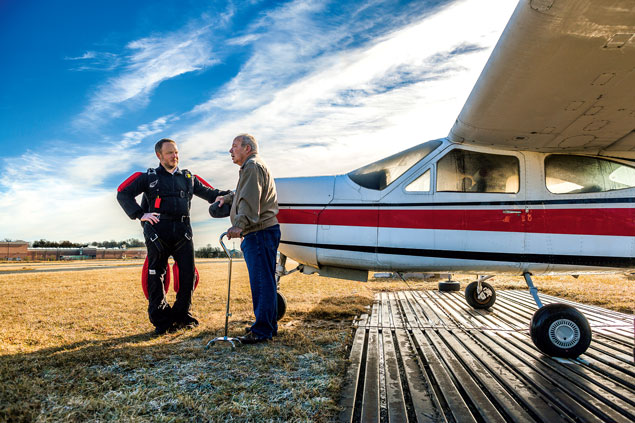
They drank Black Label beer out of kegs and cans. They tumbled out of planes drunk and hung-over and reeking of Friday and Saturday nights. They slept in the grass and on couches and in cars. They pressed their ass cheeks against car windows to shock churchgoers. They often snuck across the Chesapeake Bay Bridge without paying tolls, once stopping in the middle to pee off the side.
The Pelicans were the finest sport-parachuting club in the country, and they damn well knew it. A half century after the first powered flight, skydiving became a sensation, and nobody did it better than this group of renegades, whose home was in Ridgely, Maryland, a small town about 25 minutes east of the Chesapeake Bay.
“Everybody wanted to jump with the Pelicans,” Billy Gifford, who jumped for nearly 20 years with the group and is now in his eighties, told me last fall.
They were so wrapped up in their sport that they lived unfazed by most of the 1960s. The day after Martin Luther King Jr. was shot and killed, my father made three jumps—numbers 114, 115, and 116 in his career. They were mostly conservative white men who spent their days floating on air and didn’t want anything about that to change.
Their house, owned by the group, had several bedrooms, and guests regularly filled it. Crowds gathered wherever they went. One night after jumping, my father left in his gold Chevrolet Chevelle and returned down the long dirt driveway with two beautiful women in the front seat with him. “He was big-timing,” former Pelican Rick Young told me last year, sitting in my parents’ dining room. “He came up with one under each arm. He thought he was special.”
The next day, the police called the Pelicans’ house looking for my dad. Those beautiful women had stolen his car and taken it to Ocean City overnight. If he wanted it, he could come get it, right where they’d left it, fender in the side of a telephone pole.
Young is 67 now, and he finished with about 1,600 jumps. He fought in Vietnam. He was a US Army Golden Knight, and he once placed ninth in the world in the national skydiving competition.
He’s done all of that, but his favorite memories are of his days as a Pelican, jumping in this old group with my dad.
“If you didn’t live it, it’s really hard to describe. It makes us look like a bunch of drunken fools,” Young said. “But it’s more than that. It’s a genuine love attachment that I have with your father.”
That sentiment kept coming up during the course of my conversations. My dad’s friends loved talking to me about those days, but they wanted me to know that I probably wouldn’t understand the full measure of their connection because I hadn’t been there. And I couldn’t possibly understand if I’d never skydived. Even my father said so.
“Everyone should jump out of a plane once,” he told me, baiting me to do something he’d have forbidden me to do just 20 years before. I asked why, and he said, “Because it’s an experience you can’t get out of you.”
• • •
Jump No. 58: September 4, 1967. Altitude: 3,600 feet. Distance to target: 25 feet. Remarks: Almost caught chicken in tin foil. Mike Schultz threw it from plane.
Fearless Freddie made 54 jumps in the first three months. He completed his 100th on December 30, 1967, 11 years to the day before he married my mother. In the remarks column, he wrote one word: SCARED.
He switched back and forth from manuscript to cursive in the logbooks. On July 7, 1968, he remarked: Crews and I won the beer. On October 21, 1968, he took first place in accuracy at a meet in Downsville, in western Maryland. On November 16, 1968, he jumped five times in one day, and the only remark for all five jumps: BLAH!!!
As he accumulated more jumps, his remarks started to reveal a man who grew less enchanted by the romance of skydiving and more enchanted by competition. He participated in meets. The remarks became coldly budgetary, listing the meet location and cost of entry. He jumped in Wildwood, New Jersey, and York, Pennsylvania, and in New York’s Hudson Valley.
Then this entry: Jump 743: July 1, 1972. Altitude: 6,600. Distance to target: 0. Remarks: Broke leg.
His next logged jump was August 28, less than 60 days later.
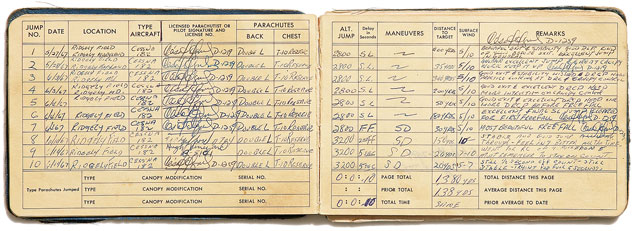
Here’s something Freddie’s younger sister remembers, back in January 1960, seven years before he’d ever touched a parachute.
He was 15 years old, and she was six. They were in the family’s townhouse in Greenbelt. Their mother was in the hospital giving birth to her ninth and final child.
The family had made arrangements for all the kids during her hospital stay. Mary would stay with friends, a married couple. The little girl wasn’t fond of these people, for whatever reasons a little girl wouldn’t be fond of strangers, and she missed her mother. So she cried.
Freddie gave Mary a bath that night before sending her off. He was the second-born, and his older brother wasn’t home, so on this night, Freddie was the eldest child in the house.
Their father was there, too, despite everyone’s wishes. The old man had fought in World War II, and when he came home he “pretty well kept my mother good and pregnant,” my dad likes to say.
“There was a time,” Mary told me this fall, “when we would’ve done anything for that man not to come home.”
That night, Freddie washed Mary, picked her up out of the tub, and placed her on the toilet seat. He started to dry her off with a towel. She cried louder. She didn’t want to go.
The old man—who became the grandfather I’d never know—had a low tolerance for children crying. He yelled from downstairs to tell the little girl to keep quiet. She cried even louder. More yelling and drying and crying. Until the bathroom door swung open. Until the old man started swinging an open palm. Until he smacked the little girl in the back of the leg, smacked her on her bottom. Freddie backed away. Until he couldn’t watch anymore.
“Quit hitting her! Quit hitting her!” Mary remembers Freddie shouting. “She’s scared!”
“I hated that son of a bitch,” my dad says now.
Mary has a similar account.
“My father was not a very good father,” she says. “There was never a pat on the back, never a ‘good job.’ There was just constant berating and belittling—put down, smacked around. There was never any encouragement. How in the world any of my brothers made out as good as they did has always amazed me.”
• • •
“Someone asked me once, ‘Where is Fred Graff?’ ” Gifford, one of the men from the logbooks, told me last fall. “I said, ‘Aw, I don’t know. He’s probably dead.’ ”
For most of the years my dad’s been a husband and father, his skydiving buddies just thought he was dead. Skydivers are like that. They talk about death as a matter of fact.
I met Gifford one time, when I was nine or ten, and we took my dad’s boat up the Chesapeake and docked at Gifford’s house on the water. I remember that trip because Gifford and his wife had a refrigerator with an ice dispenser, and I’d never seen one before. I thought it was fascinating that ice and water could fall out of a door. That was the only time I met any of my dad’s skydiving friends.
Here’s what I do remember, though, about those years his buddies thought he was dead: Fred Graff was a great father. Despite what he’d learned from his own father, despite his wild streak, he was always there. He had his flaws, but we all do. And memories of those things fade with time. When I was eight or so, I remember, we spent Christmas in the hospital. I don’t recall why, and I can’t find the records, but for some reason I associate that stay with the end of his drinking days. His mother showed up to the hospital; I remember that. My grandmother—a mother of nine and a devout Catholic—put family before anything. She asked him on that Christmas Day, “Freddie, do you want to see your boys grow up?” Those might have been the most important words of my life.
I remember, in the early years of his sobriety, running to grab nonalcoholic Kingsbury beers from the fridge in his garage. Kingsbury then turned into Coke. Then Diet Coke. The older he became, the more he tried to be healthy.
I remember I got a Transformers toy and a watch that Christmas. I took both to the hospital with me, to show my dad how a truck could turn into the powerful Optimus Prime and to show him how smart I was for understanding how to read the passage of time.
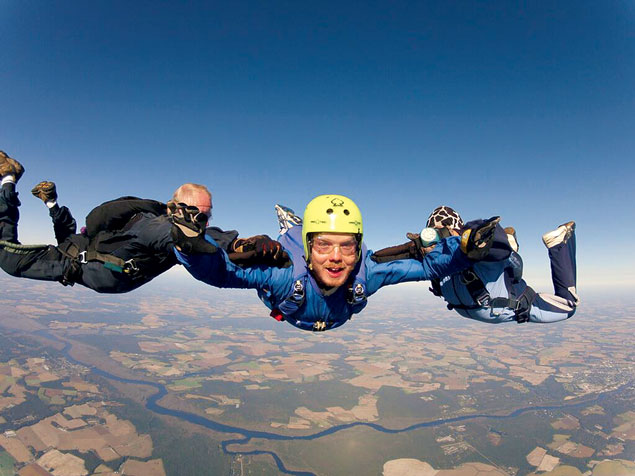
In the photo, he’s wearing a helmet, a jumpsuit, and a backpack. His head is tilted back, and he’s chugging a Black Label beer. He’s happy. If there ever was a poster image of my father, this would be it. If there ever was a picture he wouldn’t have wanted us to see while he was raising us, this would be it.
A man named Gordon Allen took that picture. Allen took almost all of the photos of the Pelicans that remain.
Allen started jumping with the group in 1967, while he was a student at the University of Maryland. He graduated with a degree in physics, and in 1971 he sold his parachute for $700 to pay for graduate school. He earned his master’s in computer science, and he later earned an MBA and moved out west to begin a successful career in finance. He wound up joining the Church of Jesus Christ of Latter-day Saints.
Before all that, though, he spent his weekends jumping out of planes and passing out in the fields with the Pelicans.
I called Allen in September at his home in Utah. Doctors had just told him he had six months to live. He was suffering from multiple myeloma, a cancer formed in the plasma cells, and a malignant tumor had spread to his kidney. He answered the phone in a deep, low voice that shot up the moment I introduced myself as Fred Graff’s son.
“I always have time for you,” he said.
For two hours, Allen and I talked about the Pelicans and Fearless Freddie.
“It was a time when we were all young enough to go do this and have no worries,” he said. “And wasn’t that great? Yes, the answer is, it was tremendous.”
In Allen’s photos, Fearless Freddie is happy. I’ve seen my dad in some of his saddest moments, and Allen has an entire slide show of him being free of everything—of money problems or dad problems or son problems or any problems.
He wasn’t the best skydiver on the team, his buddies told me, but he was the most willing. When he had only 23 jumps, a group of three needed a fourth to make a star formation in freefall. Fearless Freddie raised his hand.
One night, the Pelicans went to a bar in Ridgely. A group of about seven local boys didn’t like sharing the bar with a bunch of blustery skydivers, and a fight broke out. Pool sticks and fists flew, and the five-foot-seven Fearless Freddie was in the middle of it.
“The bartender pulled out this revolver and started shaking it,” Allen told me. “It scared me so bad I ran, but your dad got three or four more punches in before he left.”
As much fun as they had, though, there was a real, deeper bond. Yes, they had crab feasts and drank and chased women and caused trouble. But even after the wildest Saturday nights in that field on the Eastern Shore, they all rose at sunrise to the sound of the propellers thumping through the air, and they all wanted to be on the first plane up.
“The essence,” Allen told me, “is the freefall. That’s the core thing that got us in there together, this desire for just the thrill of being in freefall.”
• • •
Toward the end, he stopped recording jumps in his logbook.
The final entry didn’t even list a date, but the US Parachute Association would send him a certificate to confirm that it was August 16, 1973.
Jump No. 1,000: Altitude 2,500 feet. Distance to target: Dead center. Remarks: Got drunk.
He jumped for another year or so, then decided, like they all did, to quit. There was no defining moment, no reason.
“I just didn’t want to do it anymore,” he says now.
He believes he finished with 1,120 jumps, but he didn’t record them, and now he can’t remember.
hey, mike. just wondering what’s going on, man. I don’t know what’s going on. I’m only kidding you. Talk to you in a little while. Bye.
The Pelicans gather more often these days. Rick Young and Billy Gifford check on my father regularly. They’re preparing a reunion party in May. As they get closer to the end of their own stories, they seem to want to return to the most exciting chapter.
Ottley, the founder, died eight years ago. Young spoke at his memorial, and he told the story of the raccoon.
Ottley never reprimanded Fearless Freddie for the damage to the plane. In fact, Ottley paid the entire $8,000 bill without asking questions. Now, though, more than 40 years after he jumped into that football field and hitchhiked home to hide out for a few days, my father’s battered brain has decided it wants to own up to it. He told Young last summer that he just had to get it off his mind, to let everyone know he was the one who did it. He thought he was dropping his deepest secret, but Young responded, “We know, Fred. Hell, we all knew.”
They’re confessing things more now, knowing that the consequences don’t matter as much. They’re confessing big things, like love and admiration for one another.
When we talked in September, Allen stopped me before we hung up.
“I admired your dad—he was a good man,” Allen said. “I’m sad to know of his medical afflictions today. But I know your dad’s strong. He made a difference in my life.”
About a month after our conversation, I sent Allen an e-mail with some photos, and I thanked him for taking the time to talk to me. I remembered how he’d said, “I always have time for you,” at the start of our first conversation.
I never got a response to the e-mail.
A few weeks later, I was at work and looked down at my phone to see a message from my father.
Yes, hello, Mike? I just wanted to let you know that Gordon Allen died, on the [25th] of October. So, um, I just thought I’d let you know. Bye, now.
• • •
When you’re up in the air, 13,000 feet above the ground, standing in the doorway of a plane, the last thing you say before jumping out is “In!”
The final call should be a cadence, trying to establish a rhythm with your instructors, who will jump out on either side of you. You shout, “Check in!” and you look to the man on your right. He nods. You shout, “Check out!” and look to the man on your left. He nods. Then, “Out!”
You look inside the plane and check in one final time: “In!”
Then you step out.
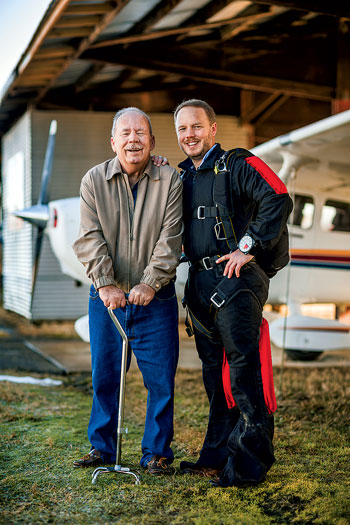
My brother and I dived for the first time on October 20 of last year. The day before we were scheduled to jump, I drove up from North Carolina, bought a few Black Label beers, and stopped to spend the night at my parents’ house. I’d planned to take my dad to the drop zone with me the next morning. But that night, while trying to get out of the shower, he fell.
These are regular events now. So much of his body is numb from the strokes, he doesn’t recognize when he’s losing his balance. Falling isn’t the hard part anymore. The trouble is getting up. He has, on more than one occasion, spent hours in the yard, unable to pull himself up with nobody around.
That night, I heard the thud and I heard my mom holler my name, and I ran into their bathroom. When I opened the door, my father was sitting on the ground in the shower. His natural reaction was to laugh. Even in that position, naked and helpless in his own bathroom, his instinct was to comfort me and my mother. But his eyes told a different story. They were wide and afraid, as if he were staring into the future, knowing that there would be more falls and no way to make them with dignity. Still, he tries. I pulled him to his feet, and he walked to the mirror to comb his hair.
People asked me whether I was scared of skydiving. No, I wasn’t.
The next morning, I left their house in southern Maryland and drove across the Bay Bridge to meet Kenny at a field in Laurel, Delaware, at a drop zone owned by Skydive Delmarva.
It was not quite 9 am when we started filling out forms taking all responsibility for the jump. The experienced skydivers were just waking up. As they stepped out of various doors and off various couches, many of them had bloodshot eyes. A red-headed man, probably in his late twenties, walked toward the hangar barefoot and wearing only shorts, carrying a helmet and a backpack while smoking a cigarette. A black cat roamed the property.
“Dad would’ve loved this,” I told Kenny.
Any thrill seeker can just show up, sign his life away, jump out of a plane in a two-man tandem, and be home in an hour. These days, you don’t have to know how to jump out of a plane to jump out of a plane.
Kenny and I wanted to know. We spent most of that Saturday in a classroom. We learned that the first rule of being able to control yourself while falling is to arch your back and stick your pelvis out. We practiced that position for a while on the ground.
The final three hours of the class were devoted to everything that could go wrong—a somewhat bad parachute, a really bad parachute, a nonexistent parachute—and how to react in those situations so we wouldn’t die.
Skydivers don’t avoid the word “death.” They mark it, somewhere off in the distance, and then they pull this cord or that cord and try to hold it off for one more jump.
• • •
Mike Schultz is 75 years old, and after nearly 50 years of skydiving he’s on track to record his 10,000th jump this October. He’s one of the names in my father’s logbooks, the one who threw the chicken out of the plane. He was the drop-zone manager in Ridgely in the late 1960s and ’70s. He was a Pelican, and he’s still jumping.
After a full day of classes on Saturday, my brother and I returned on Sunday morning, ready to skydive. That’s when we met Schultz, standing in the hangar in Delaware, a live link to our father’s skydiving days and, it turns out, one of my brother’s instructors for the day.
I was assigned to the first flight with my two instructors. Kenny and Schultz and another instructor were assigned to the second flight.
With me in it, the tiny Otter plane reached 13,000 feet at about 10 am. To the east, I could see Ocean City, Maryland. I could see Cape May, New Jersey. I was fourth in line—more experienced jumpers up front, tandem jumpers in back, the student (me) sandwiched in the middle. It happened very quickly once the door opened. The first three divers were gone before I could take a breath. I watched the third go, and it’s hard to explain the speed with which people fall, going from full-size humans to traces of themselves in less than a second. Then I was next, with my two instructors, John and Joe. I shouted.
“Check in!” John nodded.
“Check out!” Joe nodded.
“Out!” Joe nodded.
“In!”
I don’t remember anything about the first three seconds. Video would later show that I was in the wrong position, diving straight down, and my arms were scratching at the sky. I don’t remember that. John, the instructor, told me about it when we landed. “No matter how hard you try,” he said, laughing, “once you get out of a plane, you can’t get back in.”
After those first three seconds, John and Joe shook me, and suddenly I snapped to it. I remembered how to fall in the proper position. I arched. I settled into the sky.
I performed a few drills and checked the altimeter strapped to my arm, waiting for the magic number to pull the chute—5,500 feet.
At terminal velocity, a human being falls toward the earth at 120 miles per hour. That’s about 1,000 feet of sky every six seconds. So after I gathered myself and after the drills, I was at 8,500 feet, leaving me 20 seconds of pure, beautiful freefall.
• • •
I remember silence.
In the movies and videos, skydiving, like death, is often accompanied by some kind of music, as if falling has a soundtrack. It doesn’t. It is a quiet moment.
The wind rushes past at 120 miles an hour. But I was very aware that the rest of the world’s noise was down there, 8,000 or so feet, 7,000 or so feet . . . who cares? It was a mile below, along with worry, along with fear. The most memorable thing about the final stage of freefall is how little time you spend thinking about death and how much you spend thinking about life. For those 20 seconds, there is only the experience, the moment. No past. No future. No context. I couldn’t do anything but laugh.
“The essence,” I remembered Gordon Allen telling me, “is the freefall.”
At 5,500 feet, I waved off the instructors and pulled the cord. The pilot chute sprang. The parachute opened in three seconds. I looked at my altimeter, and I spoke: “Okay, 4,000 feet.” I remember my voice, I heard it clearly, the only sound in the sky. I steered myself toward the ground, alone with gravity and the breeze.
At 3,000 feet I worried that the chute would capsize. It didn’t.
At 2,000 feet I worried that I was too far along on my landing pattern and had overshot the landing area. I hadn’t.
At 1,000 feet I made the approach home. I turned right, then left, drawing an S in the sky. Then I turned to face the wind. In the final 300 feet of a long skydive, the only way to land safely is to turn into the wind, to flood the parachute with air, fulfilling its basic reason for existing.
A day earlier, our classroom instructor had told Kenny and me that just before landing, we should “flare” the parachute for a soft touchdown. By pulling down on two toggles, we would hit the brakes and coast. He told us to flare at 12 feet. Flare too early and the chute would catch too much air too soon and we’d drop hard. Flare too late and it’s just too late.
“When you think you’re ready to land, don’t flare,” he told us. “When you start to get scared, don’t flare. When you’re really scared, don’t flare. When you think you’re going to die, that’s when you flare.”
Somehow, I flared at the right time and landed standing up, walking straight from the sky to the ground.
I stripped out of my suit and went back to the field to watch Kenny’s group take off. The Otter climbed until I couldn’t see it anymore. Flags flapped softly in the breeze. Flat land stretched for miles, and in the distance blue sky curled down to touch the fields. It was peaceful. A few minutes later, bright-colored parachutes popped open against the backdrop, Kenny’s among them. He came down slowly, just as I’d done. He made an S in the sky, as I’d done. He touched down. The moment he landed, a gust of wind kicked up, inflating the parachute, yanking him on his ass. He stood up and laughed.
A few minutes later, he unhooked the parachute pack from his shoulders and took a breath. I pulled two cans of Black Label from my pockets. We popped the tops and nodded at each other. Then we drank cheap beer on a Sunday morning like we didn’t care, tilting our heads toward the big sky that had dropped us off right here.
A few minutes later, my phone rang. I answered.
“Hey, Mike,” my dad said. “It’s just me. What’s going on, man?”
Michael Graff, a Maryland native, is executive editor of Charlotte magazine. He can be reached at michaelngraff@gmail.com. This article appears in the April 2014 issue of Washingtonian.

